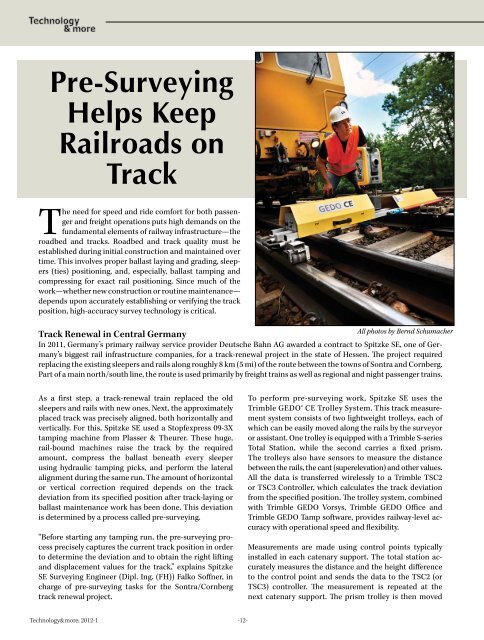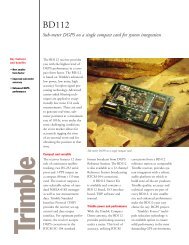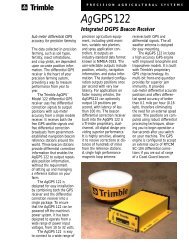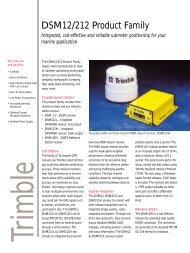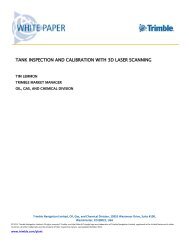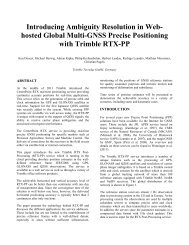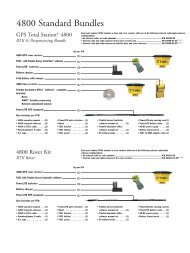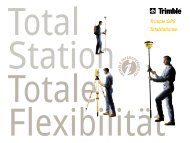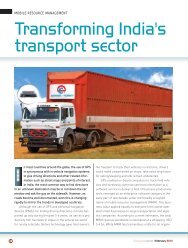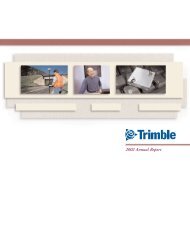Cal Stadium Renovation - Trimble
Cal Stadium Renovation - Trimble
Cal Stadium Renovation - Trimble
You also want an ePaper? Increase the reach of your titles
YUMPU automatically turns print PDFs into web optimized ePapers that Google loves.
Pre-Surveying<br />
Helps Keep<br />
Railroads on<br />
Track<br />
The need for speed and ride comfort for both passenger<br />
and freight operations puts high demands on the<br />
fundamental elements of railway infrastructure—the<br />
roadbed and tracks. Roadbed and track quality must be<br />
established during initial construction and maintained over<br />
time. This involves proper ballast laying and grading, sleepers<br />
(ties) positioning, and, especially, ballast tamping and<br />
compressing for exact rail positioning. Since much of the<br />
work—whether new construction or routine maintenance—<br />
depends upon accurately establishing or verifying the track<br />
position, high-accuracy survey technology is critical.<br />
Track Renewal in Central Germany<br />
All photos by Bernd Schumacher<br />
In 2011, Germany’s primary railway service provider Deutsche Bahn AG awarded a contract to Spitzke SE, one of Germany’s<br />
biggest rail infrastructure companies, for a track-renewal project in the state of Hessen. The project required<br />
replacing the existing sleepers and rails along roughly 8 km (5 mi) of the route between the towns of Sontra and Cornberg.<br />
Part of a main north/south line, the route is used primarily by freight trains as well as regional and night passenger trains.<br />
As a first step, a track-renewal train replaced the old<br />
sleepers and rails with new ones. Next, the approximately<br />
placed track was precisely aligned, both horizontally and<br />
vertically. For this, Spitzke SE used a Stopfexpress 09-3X<br />
tamping machine from Plasser & Theurer. These huge,<br />
rail-bound machines raise the track by the required<br />
amount, compress the ballast beneath every sleeper<br />
using hydraulic tamping picks, and perform the lateral<br />
alignment during the same run. The amount of horizontal<br />
or vertical correction required depends on the track<br />
deviation from its specified position after track-laying or<br />
ballast maintenance work has been done. This deviation<br />
is determined by a process called pre-surveying.<br />
“Before starting any tamping run, the pre-surveying process<br />
precisely captures the current track position in order<br />
to determine the deviation and to obtain the right lifting<br />
and displacement values for the track,” explains Spitzke<br />
SE Surveying Engineer (Dipl. Ing. (FH)) Falko Soffner, in<br />
charge of pre-surveying tasks for the Sontra/Cornberg<br />
track renewal project.<br />
Technology&more; 2012-1<br />
-12-<br />
To perform pre-surveying work, Spitzke SE uses the<br />
<strong>Trimble</strong> GEDO® CE Trolley System. This track measurement<br />
system consists of two lightweight trolleys, each of<br />
which can be easily moved along the rails by the surveyor<br />
or assistant. One trolley is equipped with a <strong>Trimble</strong> S-series<br />
Total Station, while the second carries a fixed prism.<br />
The trolleys also have sensors to measure the distance<br />
between the rails, the cant (superelevation) and other values.<br />
All the data is transferred wirelessly to a <strong>Trimble</strong> TSC2<br />
or TSC3 Controller, which calculates the track deviation<br />
from the specified position. The trolley system, combined<br />
with <strong>Trimble</strong> GEDO Vorsys, <strong>Trimble</strong> GEDO Office and<br />
<strong>Trimble</strong> GEDO Tamp software, provides railway-level accuracy<br />
with operational speed and flexibility.<br />
Measurements are made using control points typically<br />
installed in each catenary support. The total station accurately<br />
measures the distance and the height difference<br />
to the control point and sends the data to the TSC2 (or<br />
TSC3) controller. The measurement is repeated at the<br />
next catenary support. The prism trolley is then moved


